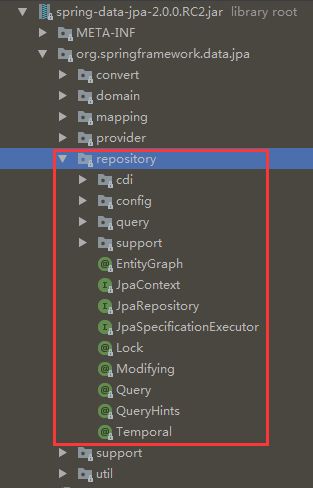1. 起因
- 接触Spring data Jpa的时间不长,在一次SpringBoot项目中添加了一个Entity,并将其映射到对应的Mysql数据库表中,
id在数据库表中是自增长类型,(说明:getXXX和setXXX方法使用lombok注解自动生成)如下:
import lombok.Getter;
import lombok.Setter;
import javax.persistence.*;
import java.util.Date;
@Getter
@Setter
@Entity
@Table(name = "t_user")
public class User {
@Id
private int id;
private String username;
private String userAd;
}
- Dao层接口继承自
JpaRepository类,声明的空接口(继承的父类中有常用的方法实现)如下:
import com.maxus.portal.api.entity.User;
import org.springframework.data.jpa.repository.JpaRepository;
import org.springframework.stereotype.Repository;
@Repository
public interface UserRepository extends JpaRepository {
}
- 然后在程序中生成了一堆
User的实例对象,然后放入List中,使用saveAll(list);向数据库中持久化数据。控制台报出以下错误:
NonUniqueObjectException: A different object with the same identifier value was already associated with the session
2. 解决办法
- 向
User实体类中的主键上(在本例中就是id)添加以下注解:
@GeneratedValue(strategy = GenerationType.IDENTITY)
即:
......省略
@Id
@GeneratedValue(strategy = GenerationType.IDENTITY)
private int id;
private String username;
private String userAd;
......省略
到这里问题就得以顺利解决,希望能帮助到遇到相同问题的小伙伴们。想了解原因的可以继续往下看。
此问题产生的原因
- 我使用的框架是SpringBoot,首先谈论一下Jpa、Spring Data Jpa、Hibernate三者的关系:
JPA的是 Java Persistence API 的简写,是Sun官方提出的一种ORM规范,注意不是ORM框架——因为JPA并未提供ORM实现,它只是制订了一些规范,提供了一些编程的API接口,但具体实现则由服务厂商来提供实现。
Hibernate是JPA规范的完整实现,并已获得Sun的兼容认证。
Spring Data JPA是Spring官方在JPA规范的基础下,只提供了Repository层的实现。
- 因此,SpringBoot中的ORM框架也是有Hibernate的。
- 进入正题,这个异常就是Hibernate抛出的,我们先看下
NonUniqueObjectException这个异常的Hibernate官方表述:
public class NonUniqueObjectException extends HibernateException
This exception is thrown when an operation would break session-scoped identity. This occurs if the user tries to associate two different instances of the same Java class with a particular identifier, in the scope of a single Session.
翻译过来的意思就是(翻译的比较生硬,望见谅,笔芯):
当操作将破坏Session范围内的标识时,将抛出此异常。如果用户试图将同一个Java类的两个不同实例与一个特定标识符(在一个Session范围内)关联,就会发生这种情况。
步入重点:
- 大致的意思就是说主键不唯一。
- 但是数据库中明明设置的id为自增长,为什么还会出现主键不唯一呢?
- 熟悉Hibernate的应该会知道它的缓存。 底层使用
session.save();保存对象,这个时候Session将这个对象放入entityEntries,用来标记对象已经和当前的Session建立了关联,由于应用对对象做了保存的操作,Session还要在insertions中登记应用的这个插入行为(行为包括:对象引用、对象id、Session、持久化处理类)。即,调用session.save(user);之后,hibernate并不会立即提交数据库,而是先将要保存,更新,删除放进了缓存中。等整个事务操作完成后,事务提示,需要将所有缓存flush入数据库,Session启动一个事务,并按照insert,update,...,delete的顺序提交所有之前登记的操作(注意:所有insert执行完毕后才会执行update,这里的特殊处理也可能会将你的程序搞得一团遭,如需要控制操作的顺序,需要使用flush)。
- 每次调用
sessionFactory.getCurrentSession().save(user);的时候,Hibernate把user实例对象保存到了缓存中,因为在数据库表中设置的主键id是自增长的,但是在程序中save时,并没有给User类的每个实例的id赋值。那么在遍历保存第二个user的时候,这两个实例在缓存中就没有唯一标识,所以Hibernate就会认为具有相同标识符值的另一个对象已经与Session相关联。也就是上面抛出的那个异常:
NonUniqueObjectException: A different object with the same identifier value was already associated with the session
- 在主键
id上添加注解@GeneratedValue(strategy = GenerationType.IDENTITY),就是告诉它这个主键会由数据库自动生成。因此在缓存中会给每个实例添加一个标识,用以区分所有的实例,在提交给数据库后并不会对主键id产生影响。
1. 关于@GeneratedValue
为主键的值提供生成策略的规范。
@GeneratedValue注解可以被应用于一个实体或者结合@Id注解映射的父类的主键属性或者字段,使用@GeneratedValue注解只支持简单的主键,对于派生的主键则不支持。
- 这段文字是我翻译的官方文档,略显生硬,旺各位看官见谅,下面贴出来英文原文:
Provides for the specification of generation strategies for the values of primary keys. The @GeneratedValue annotation may be applied to a primary key property or field of an entity or mapped superclass in conjunction with the @Id annotation. The use of the @GeneratedValue annotation is only required to be supported for simple primary keys. Use of the @GeneratedValue annotation is not supported for derived primary keys.
2. 关于GenerationType
GenerationType是一个Enum类型的枚举类,定义主键生成策略的类型。
GenerationType.IDENTITY的意思就是指示持久化提供器必须使用数据库标识列为实体分配主键。
- 该枚举类的源码如下,属性上面有相关注释。
public enum GenerationType {
/**
* Indicates that the persistence provider must assign
* primary keys for the entity using an underlying
* database table to ensure uniqueness.
*/
TABLE,
/**
* Indicates that the persistence provider must assign
* primary keys for the entity using a database sequence.
*/
SEQUENCE,
/**
* Indicates that the persistence provider must assign
* primary keys for the entity using a database identity column.
*/
IDENTITY,
/**
* Indicates that the persistence provider should pick an
* appropriate strategy for the particular database. The
* AUTO generation strategy may expect a database
* resource to exist, or it may attempt to create one. A vendor
* may provide documentation on how to create such resources
* in the event that it does not support schema generation
* or cannot create the schema resource at runtime.
*/
AUTO
}
文中描述如有不正确的地方,欢迎指正。
参考链接
